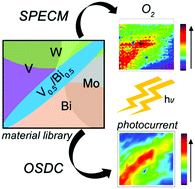Unraveling compositional effects on the light-induced oxygen evolution in Bi(V–Mo–X)O4 material libraries†
Abstract
The influence of co-deposited transition metals X (X = Ta, W, Nb) with various relative concentrations on the photoelectrochemical performance of BiVO4 is investigated. Thin film material libraries with well-defined composition gradients of Bi, V and two transition metals are fabricated by combinatorial sputter co-deposition. Materials with the highest photoelectrochemical performance are identified by high-throughput characterization of the Bi(V–Mo–X)O4 material libraries using an optical scanning droplet cell. Bi(V–Mo–W)O4 and Bi(V–Mo–Nb)O4 material libraries show the highest improvement in the photocurrent, with ten times higher photocurrents of up to 1 mA cm−2 compared to a BiVO4 reference material library. Deviations from the V : Bi equiatomic ratio lead to a decrease in the photocurrent for pristine monoclinic BiVO4. By the addition of transition metals this effect is minimized and no significant decrease in the photocurrent occurs up to 10 at% variation from the equiatomic V : Bi ratio. Excellent photoelectrochemical performance is reached under these conditions in regions with a V : Bi atomic ratio of 70 : 30 and co-deposited Nb concentrations of >10 at%. Scanning photoelectrochemical microscopy allows the evaluation of the correlation between the generated oxygen at a photoanode and the measured photocurrent.



 Please wait while we load your content...
Please wait while we load your content...